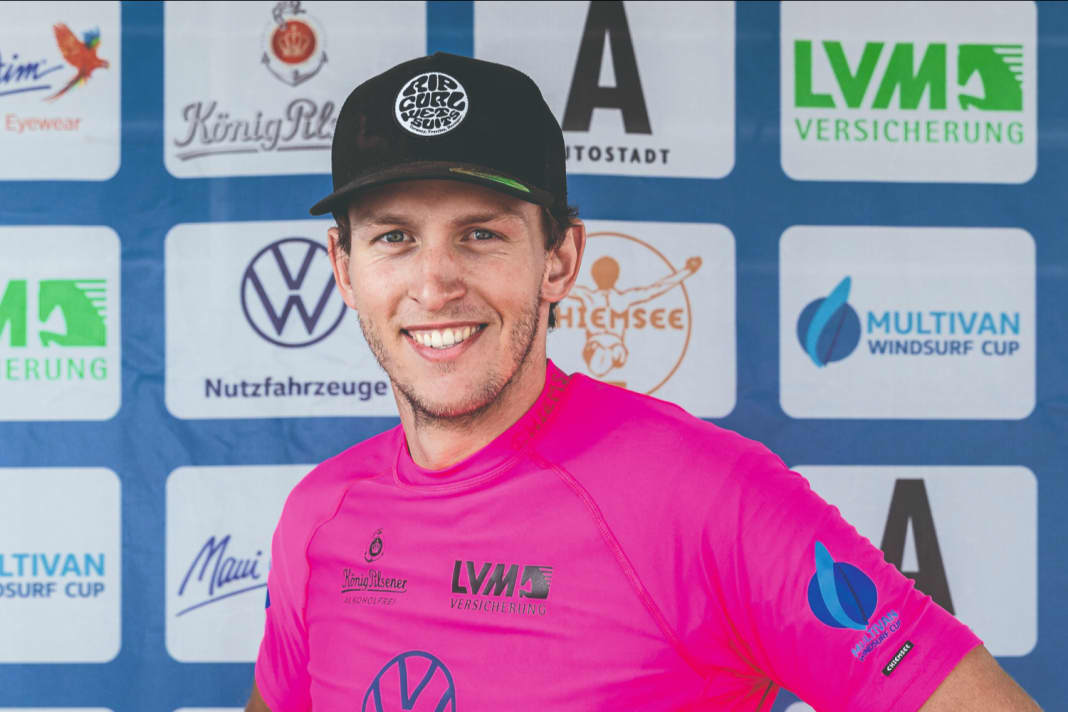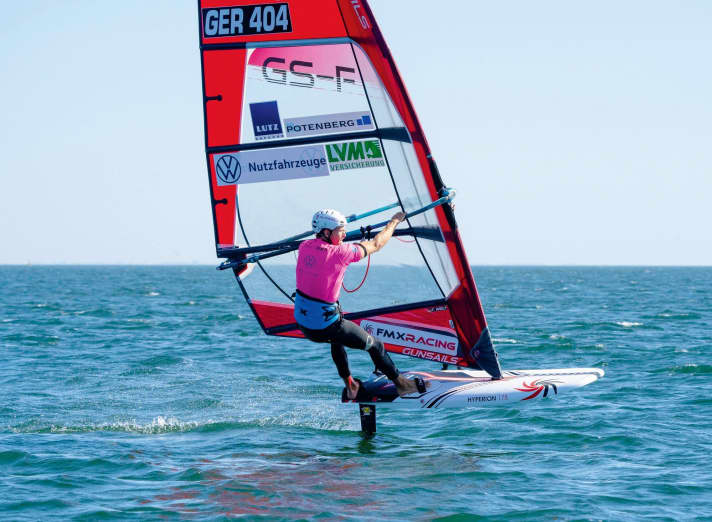Fabian Wolf on the iQFoil material: "Keep it tight and don't think too much!"
Stephan Gölnitz
· 07.10.2023




What material do you use in addition to the IQ set?
In foil slalom I ride for Gunsails and FMX Racing as well as the Z-Foil. I have two boards. A 91 (Red.: board width) with 178 litres and an 85 with 158 litres. In winds between seven and 18 knots, I normally use the 91 board and sails between 7.8 and 9.8 square metres. I also use wings with a surface area of 820 or 680 square centimetres. As soon as it gets windier, I switch quite quickly to the 85 board with front wings with a surface area of between 680 and under 500 square centimetres and sails of up to 4.5 square metres. With the 680 square metre wing, you can sail at a constant 12 knots with a 9.0 metre sail. The new, small high-aspect wings work very early on. As soon as you are up, you have enough lift and are much faster than with the 900-metre wing from the iQFoil, for example.
- iQFoil in self-experiment - Meeting with the monster

For which courses is your foil slalom equipment optimised?
The slalom material is optimised for half-wind and downwind courses. It is not suitable for upwind surfing. These are pure slalom set-ups.
How do the prices in the iQ class compare?
We also ride a slalom, but it differs from the format in the PWA. The course starts with a long reach, which is about half-wind/downwind, then it goes onto a 300 metre deep downwind course without buoys. There are two jibes on this section and you are free to choose your course up to the leeward buoy. This is followed by two half-wind/downwind reaches to the finish.
In addition, course races are surfed?
Yes exactly, similar to the Formula or RS:X.
Is the iQ material adapted to this?
The iQ material can be ridden well on the courses. The sail and the whole set-up in general have a wide wind range. It works well up to around 27 or 28 knots, after that it's increasingly a question of survival.
What's the strongest wind you've surfed in on the iQFoil?
Over 35 knots in gusts. The competition format provides for wind speeds of between seven and 35 knots. We had conditions like that at the European Championships in Patras - it gets tough above 30 knots. But we have to get through it.

What changes can be made to the material for such strong winds?
You can change the power and rake of the foil. In strong winds, I set a little more rake. Rake is the angle between the board and foil. This gives you more control when setting off and the board doesn't stick to the water as much. I would also depower the foil, i.e. give the backwing less angle. There are spacers with different thicknesses such as plus one, plus 0.5 and zero. In strong winds, I would fit the zero spacer. I push the base plate a little further forward and trim the sail one to two centimetres further. To do this, I lower the boom and set the harness lines longer. This gives the material as much control as possible.
Can you explain how to change the rake of the foil?
There are shims (washers) for this, usually from the 3D printer, which are placed in the foil box to change the angle. We measure the angle between the board and the front wing and aim for values of 1.5 to just under three degrees.
Hobby surfers rarely do that.
Yes, some have set far too little rake. If the rake is less than one degree, the nose of the board is already pointing slightly downwards. Then you won't be able to fly with every touch down because the board will get stuck. If you optimise that - it makes it so much easier. If you adjust the rake, that's a game changer.
Keep your rag tight and don't think too much!"
How long do you have to train to foil at 30 knots with the 9.0?
This requires a mixture of practice, commitment and riding technique. A lot depends on your mental attitude: keeping the rag tight and not thinking too much. If you think too much, you'll go down the drain. You just have to go for it. You can't practise it much either, because conditions like this don't happen often.
On a space wind course, it is probably a challenge to even go into the rear foot strap, as you could see in livestreams?
That's no problem up to 20 knots. But when the sail is totally overloaded with power, you can no longer control the board with your back foot on the edge. I then place my foot further forward on the centre of the board, as this allows me to react more quickly to the rise and fall of the foil.
In which wind range is the IQ material really suitable?
If you don't specialise in pumping up in extremely light winds, you can get on the foil at around eight to ten knots and then go up to 18 knots without any problems.
And for which courses is the IQ material best suited?
You can ride all courses in the wind range from eight to 18 knots. But what I particularly love is upwind surfing, just getting stuck in, you don't have to worry about anything. Downwind surfing requires a lot more technique, but anyone can do upwind surfing and it's great fun.
But at some point you have to go back?
You can always get down somehow by manoeuvring downwind. But it takes a lot of practice to go downwind really quickly and in a controlled manner.
You can take the almost direct route, very deep, or only a little deeper than half wind. What do you recommend if you're still unsure?
In competition, the following applies: really deep and slow is worse than not quite so deep and fast. For beginners, however, it is easier to ride slowly and deep at first instead of pushing yourself unconditionally and then becoming really fast with a less deep angle.
The iQFoil has no chance against newer high-performance foils and new slalom foil sails."
How does the performance of IQ material compare to foil slalom material?
When it comes to staying on the foil at all at the lower limit, you can be competitive with the IQ material. It offers extremely high buoyancy and stability in light winds. However, as soon as you take off effortlessly - from around 10 knots - the IQ has no chance against the high performance foils and new slalom foil sails. The foil has too much surface area and is too thick. And the sail is a compromise between a slalom and course racing sail with a long boom; in tight gybes, it comes towards you with a counter-belly. The new foil slalom sails have a longer mast and a narrower outline, which means you have almost no counter-belly and can carve and attack with much more speed.
Do you have any riding technique tips for skiing?
In light winds, you should lean the sail really far forwards - front arm long - and hold it close with the back arm so that the lower leech is almost against your shin. Then sail downwind - not too fast - to avoid a counter-belly.
The IQ-Set was very stable in flight during our test.
Yes, the IQ is very stable and easy to sail in light winds, even for foil beginners. But you only have one wing and one sail. On the IQ you therefore have to work in strong winds, on the foil slalom material you just hang in and fly with smaller sails and wings at much more speed.
Do you really need new equipment every year in foil slalom?
It depends on the rider, some can compensate for everything. But with Gunsails, for example, this year's sails are at a new level. With little wind, it also depends very much on the rider: whether he is fit and can pump a lot. But I don't think I would have become German champion in the foil slalom on Sylt this year without the new sails.
Would you recommend the IQ to someone who wants to use it as a light wind freerace foil?
Definitely. It's perfect for hobby racers who don't intend to compete in high-performance races. And it is available second-hand at a favourable price.
iQ material is perfect for hobby racers who have no intention of taking part in high-performance races."
Are there still useful tuning options?
The 800 front wing from the Youth board is an option if the 900 has too much power or if you want to go more in the direction of speed.
But in the official IQ class you don't have to make many adjustments to the material?
Although everyone uses the same material, it becomes a big material battle because not everything comes from the same production line. The variations in foil and sail mast are huge. Riders who have 20 masts simply have a better chance of finding a really good mast. As a result, the material battle gets a bit out of hand for some. The positive thing is that you can ride with just one set.
What else speaks in favour of the iQFOiL class?
Not just the prospect of the Olympics. You can qualify for various squads and, from a certain level, you have a completely different financial background to normal windsurfing. You get regular training through the association, you get into the sports aid programme and you can apply to the police or the army. That's really good at IQ and not at all comparable to what happens in the open area.
Have you ever surfed the iQ-Board with smaller sails?
I know that it works. I know an older regatta surfer for whom the 9.0 sail had too much power and was too heavy. He then first tried the 8.0 ladies' sail and finally got the 7.0 IQ youth sail. It doesn't have such a wide mast sleeve. He sails it on the IQ board without any problems and it works great.


